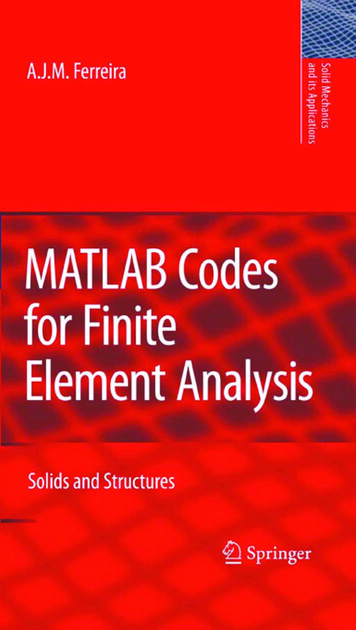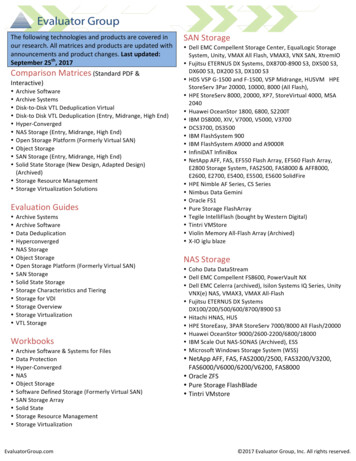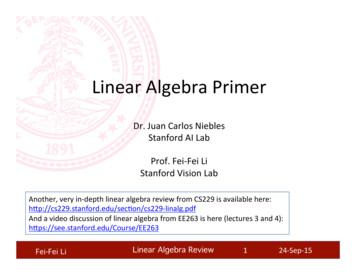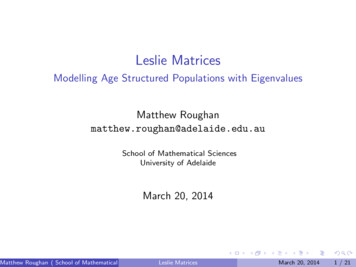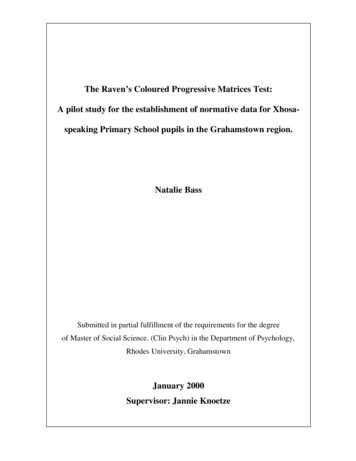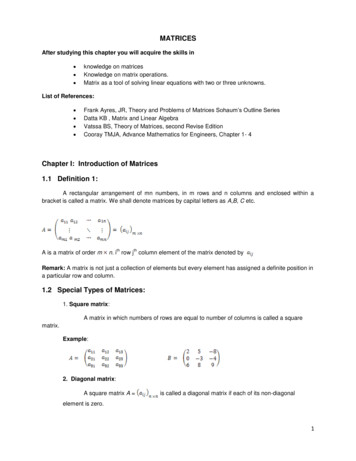
Transcription
MATRICESAfter studying this chapter you will acquire the skills in knowledge on matricesKnowledge on matrix operations.Matrix as a tool of solving linear equations with two or three unknowns.List of References: Frank Ayres, JR, Theory and Problems of Matrices Sohaum’s Outline SeriesDatta KB , Matrix and Linear AlgebraVatssa BS, Theory of Matrices, second Revise EditionCooray TMJA, Advance Mathematics for Engineers, Chapter 1- 4Chapter I: Introduction of Matrices1.1 Definition 1:A rectangular arrangement of mn numbers, in m rows and n columns and enclosed within abracket is called a matrix. We shall denote matrices by capital letters as A,B, C etc.A is a matrix of order mththn. i row j column element of the matrix denoted byRemark: A matrix is not just a collection of elements but every element has assigned a definite position ina particular row and column.1.2 Special Types of Matrices:1. Square matrix:A matrix in which numbers of rows are equal to number of columns is called a squarematrix.Example:2. Diagonal matrix:A square matrix A is called a diagonal matrix if each of its non-diagonalelement is zero.1
That isand at least one element.Example:3. Identity MatrixA diagonal matrix whose diagonal elements are equal to 1 is called identitymatrix and denoted by .That isExample:4. Upper Triangular matrix:A square matrix said to be a Upper triangular matrix if.Example:5. Lower Triangular Matrix:A square matrix said to be a Lower triangular matrix if.Example:6. Symmetric Matrix:A square matrix A said to be a symmetric iffor all i and j.Example:2
7. Skew- Symmetric Matrix:A square matrix A said to be a skew-symmetric iffor all i and j.Example:8. Zero Matrix:A matrix whose all elements are zero is called as Zero Matrix and ordermatrix denoted byZero.Example:9. Row VectorA matrix consists a single row is called as a row vector or row matrix.Example:10. Column VectorA matrix consists a single column is called a column vector or column matrix.Example:Chapter 2: Matrix Algebra2.1. Equality of two matrices:Two matrices A and B are said to be equal if(i) They are of same order.(ii) Their corresponding elements are equal.That is if A thenfor all i and j.3
2.2. Scalar multiple of a matrixLet k be a scalar then scalar product of matrix A given bykA given denoted by kA andor2.3. Addition of two matrices:Let A andare two matrices with same order then sum of thetwo matrices are given byExample 2.1: letandFind (i) 5B(ii) A B.(iii) 4A – 2B (iv) 0 A2.4. Multiplication of two matrices:Two matrices A and B are said to be confirmable for product AB if number of columns inA equals to the number of rows in matrix B. Let A be twomatrices the product matrix C AB, is matrix of order mExample 2.2: LetCalculater whereand(i) AB(ii) BA(iii) is AB BA ?2.5. Integral power of Matrices:Let A be a square matrix of order n, and m be positive integer then we define(m times multiplication)2.6. Properties of the MatricesLet A, B and C are three matrices and(i)are scalars thenAssociative Law4
(ii)Distributive law(iii)Associative Law(iv)Associative Law(v)Associative Law(vi)Distributive law2.7. Transpose:The transpose of matrix A , written(is the matrix obtainedby writing the rows of A in order as columns.That is.Properties of Transpose:(i)(ii) A(iii) kfor scalar k.(iv)Example 2.3: Using the following matrices A and B, Verify the transpose properties,Proof: (i) Letandare theis theAlsoelement of matrixandare theis the(ii) Letelement of the matrix A and B respectively. Thenand it iselement of the matrixelement of the matrixelement of the matrixelement of the matrix A isandrespectively. Therefore , it iselement of thethen it iselement of the matrix(iii) try(iv)is thethelement ofththe AB It is result of the multiplication of the i row and k column and it iselement of the matrix.th,element is the multiplication of k row ofththwith i column of,thThat is k column of B with i row of A.5
2.8 A square matrix A is said to be symmetric if.Example:, A is symmetric by the definition of symmetric matrix.ThenThat is2.9 A square matrix A is said to be skew- symmetric ifExample:(i)andare both symmetric.(ii)is a symmetric matrix.(iii)is a skew-symmetric matrix.(iv)If A is a symmetric matrix and m is any positive integer thenis also symmetric.(v)If A is skew symmetric matrix then odd integral powers of A is skew symmetric,while positive even integral powers of A is symmetric.If A and B are symmetric matrices then(vi)is symmetric.(vii)is skew-symmetric.Exercise 2.1: Verify the (i) , (ii) and (iii) using the following matrix A.Chapter 3: Determinant, Minor and Adjoint MatricesDefinition 3.1:Let A be a square matrix of order n , then the numbercalled determinantof the matrix A.(i) Determinant of 22 matrix6
Let A then(ii) Determinant of 3 3 matrixLet B Then Exercise 3.1: Calculate the determinants of the following matrices(i)(ii)3.1 Properties of the Determinant:a. The determinant of a matrix A and its transposeare equal.b. Let A be a square matrix(i) If A has a row (column) of zeros then(ii) If A has two identical rows ( or columns) thenc. If A is triangular matrix thenis product of the diagonal elements.d. If A is a square matrix of order n and k is a scalar then3.2 Singular MatrixIf A is square matrix of order n, the A is called singular matrix whenand non-singular otherwise.3.3. Minor and Cofactors:Let A is a square matrix. Then(n-1) obtained by deleting itsminor of the elementThe cofactor ofrow anddenote a sub matrix of A with order (n-1)column. The determinantis called theof A.denoted byand is equal to.Exercise 3.2: Let(i)Compute determinant of A.7
(ii)Find the cofactor matrix.3.4. Adjoin Matrix:The transpose of the matrix of cofactors of the elementof A denoted byis calledadjoin of matrix A.Example 3.3: Find the adjoin matrix of the above example.Theorem 3.1:For any square matrix A,where I is the identity matrix of same order.Proof: Let A Since A is a square matrix of order n, thenalso in same order.ConsiderthenNow consider the product( as we know thatandwhen)8
Whereis unit matrix of order n.Theorem 3.2: If A is a non-singular matrix of order n, thenProof:.By the theorem 1Theorem 3.3: If A and B are two square matrices of order n thenProof: By the theorem 1ThereforeConsider, (i)Also consider . (ii)9
Therefore from (i) and (ii) we conclude thatSome results of adjoint(i)For any square matrix A(ii) The adjoint of an identity matrix is the identity matrix.(iii) The adjoint of a symmetric matrix is a symmetric matrix.Chapter4: Inverse of a Matrix and Elementary Row Operations4.1 Inverse of a MatrixDefinition 4.1:If A and B are two matrices such thatThe inverse of A is denoted by, then each is said to be inverse of the other.Theorem 4.1: (Existence of the Inverse)The necessary and sufficient condition for a square matrix A to have an inverse is that(That is A is non singular).Proof: (i) The necessary conditionLet A be a square matrix of order n and B is inverse of it, thenTherefore.(ii) The sufficient condition:If, the we define the matrix B such thatThen SimilarlyThus hence B is inverse of A and is given byTheorem 4.2: (Uniqueness of the Inverse)Inverse of a matrix if it exists is unique.10
Proof: Let B and C are inverse s of the matrix A thenandExample 6: LetfindTheorem 4.3: (Reversal law of the inverse of product)If A and B are two non-singular matrices of order n, then (AB) is also non singular and.Proof:Since A and B are non-singular, therefore, then.Consider (1)Similarly .(2)From (1) and (2) Therefore by the definition and uniqueness of the rn,then.Theorem 4.4: If A is a non-singular matrix of order n thenProof: Sincetherefore the matrix.is non-singular andexists.LetTaking transpose on both sides we getTherefore11
That is.Theorem 4.5: If A is a non-singular matrix , k is non zero scalar, thenProof: Since A is non-singular matrix.exits.Let considerThereforeis inverse ofBy uniqueness if inverseTheorem 4.6: If A is a non-singular matrix then.Proof: Since A is non-singular matrix,exits and we haveThereforeThen4.2 Elementary Transformations:Some operations on matrices called as elementary transformations. There are six typesof elementary transformations, three of then are row transformations and other three ofthem are column transformations. There are as follows(i)(ii)(iii)Interchange of any two rows or columns.Multiplication of the elements of any row (or column) by a non zero number k.Multiplication to elements of any row or column by a scalar k and addition of it tothe corresponding elements of any other row or column.We adopt the following notations for above transformations(i)(ii)(iii)ththInterchange of i row and j row is denoted bythMultiplication by k to all elements in the i row.thMultiplication to elements of j row by k and adding them to the correspondingthelements of i row is denoted by.4.2.1 Equivalent Matrix:A matrix B is said to be equivalent to a matrix A if B can be obtained from A, by for forming finitelymany successive elementary transformations on a matrix A.Denoted by A B.12
4.3 Rank of a Matrix:Definition:A positive integer ‘r’ is said to be the rank of a non- zero matrix A if(i)(ii)There exists at least one non-zero minor of order r of A andEvery minor of order greater than r of A is zero.The rank of a matrix A is denoted by.4.4 Echelon Matrices:Definition 4.3:A matrixis said to be echelon form (echelon matrix) if the number of zerospreceding the first non zero entry of a row increasing by row until zero rows remain.In particular, an echelon matrix is called a row reduced echelon matrix if the distinguishedelements are(i)(ii)The only non- zero elements in their respective columns.Each equal to 1.Remark: The rank of a matrix in echelon form is equal to the number of non-zero rows of the matrix.Example 4.1:Reduce following matrices to row reduce echelon form(i)(ii)Chapter 5: Solution of System of Linear Equation by Matrix Method5.1 Solution of the linear system AX BWe now study how to find the solution of system of m linear equations in n unknowns.Consider the system of equations in unknownsas .13
is called system of linear equations with n unknownsconstants. If theare all zero then the system is said to be homogeneous type.The above system can be put in the matrix form asAX BWhereX The matrixB is called coefficient matrix, the matrix X is called matrix of unknowns andB is called as matrix of constants, matrices X and B are of order.Definition 5.1: (consistent)A set of values ofwhich satisfy all these equationssimultaneously is called the solution of the system. If the system has at least one solutionthen the equations are said to be consistent otherwise they are said to be inconsistent.Theorem 5.2:A system of m equations in n unknowns represented by the matrix equation AX Bisconsistent if and only if. That is the rank of matrix A is equal to rank ofaugment matrix ()Theorem 5.2:If A be an non-singular matrix, X be anmatrix and B be anmatrix then thesystem of equations AX B has a unique solution.(1)Inconsistent ifConsistent ifUnique solution if r nInfinite solution if r n14
(2)IfTrivial solutionIfInfinite solutionsTherefore every system of linear equations solutions under one of the following:(i)(ii)(iii)There is no solutionThere is a unique solutionThere are more than one solutionMethods of solving system of linear Equations:5.1 Method of inversesion:Consider the matrix equationConsider the matrix equationWherePre multiplying byThus, we have, has only one solution ifand is given by.5.2 Using Elementary row operations: (Gaussian Elimination)Suppose the coefficient matrix is of the type. That is we have m equations in nunknowns Write matrixand reduce it to Echelon augmented form by applyingelementary row transformations only.Example 5.1: Solve the following system of linear equations using matrix method(ii)15
Example 5.2: Determine the values of a so that the following system in unknowns x, y and z has(i)(ii)(iii)No solutionsMore than one solutionsA unique solutionChapter 6: Eigen values and Eigenvectors:If A is a square matrix of order n and X is a vector in, ( X considered ascolumn matrix), weare going to study the properties of non-zero X, where AX are scalar multiples of one another. Suchvectors arise naturally in the study of vibrations, electrical systems, genetics, chemical reactions, quantummechanics, economics and geometry.Definition 6.1:If A is a square matrix of order n , then a non-zero vector X infor some scalar . The scalaris called eigenvector of A ifis called an eigenvalue of A, and X is said to be an eigenvector of Acorresponding to .Remark: Eigen values are also called proper values or characteristic values.Example 6.1: The vectoris an eigenvector of A Theorem 6.1: If A is a square matrix of order n andonly ifis a real number, thenis an eigenvalue of A if and.Proof: Ifis an eigenvalue of A, the there exist a non-zero X a vector insuch that.Where I is a identity matrix of order n.The equation has trivial solution when if and only ifand only ifConversely , if. The equation has non-zero solution if 0. 0 then by the result there will be a non-zero solution for the equation,16
That is, there will a non-zero X insuch that, which shows thatis an eigenvalue of A.Example 6.2: Find the eigen values of the matrixes(i)A (ii) BTheorem 6.2:If A is anmatrix andis a real number, then the following are equivalent:(i)is an eigenvalue of A.(ii)The system of equationshas non-trivial solutions.(iii) There is a non-zero vector X in(iv)such thatIs a solution of the characteristic equation. 0.Definition 6.2:Let A be anthe identitymatrix andbe the eigen value of A. The set of all vectors X inwhich satisfyis called the eigen space of a corresponding to . This is denoted by.Remark:The eigenvectors of A corresponding to an eigen value. Equivalently the eigen vectors corresponding toare the non-zero vectors of X that satisfyare the non zero in the solution space of. Therefore, the eigen space is the set of all non-zero X that satisfywithtrivial solution in addition.Steps to obtain eigen values and eigen vectorsStep I : For all real numbersform the matrixStep II: EvaluateThat is characteristic polynomial of A.Step III: Consider the equationfor Let( The characteristic equation of A) Solve the equationbe eigen values of A thus calculated.Step IV: For eachconsider the equationFind the solution space of this system which an eigen spacethe eigen valueof A, corresponding toof A . Repeat this for eachStep V: From step IV , we can find basis and dimension for each eigen spaceforExample 6.3:Find (i)(ii)(iii)Characteristic polynomialEigen valuesBasis for the eigen space of a matrix17
Example 6.4:Find eigen values of the matrixAlso eigen space corresponding to each value of A. Further find basis and dimension for the same.6.2 Diagonalization:Definition 6.2.1: A square matrix A is called diagonalizable if there exists an invertible matrix P such thatis a diagonal matrix, the matrix P is said to diagonalizable A.Theorem 6.2.1: If A is a square matrix of order n, then the following are equivalent.(i)(ii)A is diagonizible.A has n linearly independent eigenvectors.Procedure for diagonalizing a matrixStep I: Find n linearly independent eigenvectors of A, sayStep II: From the matrix P havingStep III: The matrixentries, whereas its column vectors.will then be diagonal withis the eigenvalue corresponding toas its successive diagonal.Example 6.3: Find a matrix P that diagonalizes18
Tutorial (Matrices)Q1. Show that the square matrixQ2. Ifis a singular matrix.determine (i)(ii) Adj AQ3. Find the inverse of the matrixQ4. Ifand(i)determine(ii) AB(iii)AQ5. Consider the matrix(i)(iii)ComputeVerify(ii) find adj AI(iv) FindQ6. Find the possible value of x can take, given thatsuch thatQ7.If.find the values of m and n given thatQ8. Find the echelon form of matrix: 1 1 1 1 2 3 4 5 Hence discuss (1) unique solution (ii) many solutions and (iii) No solutions of 4 9 16 25 the following system and solve completely.x y z 12x 3y 4z 519
4x 9y 16z 25 0 1 0 32Q9. If matrix A is 0 0 1 and I, the unit matrix of order 3, show that A pI qA rA . p q r Q10. Let A be a square matrixa. Show thatb. Show thatQ11. Find values of a,b and c so that the graph of the polynomialpasses throughthe points (1,2), (-1,6) and (2,3).Q12. Find values of a,b and c so that the graph of the polynomialpasses throughthe points (-1,0) and has a horizontal tangent at (2,-9).Q13. Letbe the augmented matrix for a linear- system. For what value of a and b doesthe system havea.b.c.d.a unique solutiona one- parameter solutiona two parameter- solutionno solutionQ14. Find a matrix K such thatgiven thata. For the triangle below, use trigonometry to showAnd then apply Crame’s Rule to showUse the Cramer’s rule to obtain similar formulas forand.20
A matrix whose all elements are zero is called as Zero Matrix and order Zero matrix denoted by . Example: 9. Row Vector A matrix consists a single row is called as a row vector or row matrix. Example: 10. Column Vector A matrix consists a single column is called a column vector or column matrix. Example: Chapter 2: Matrix Algebra 2.1.



